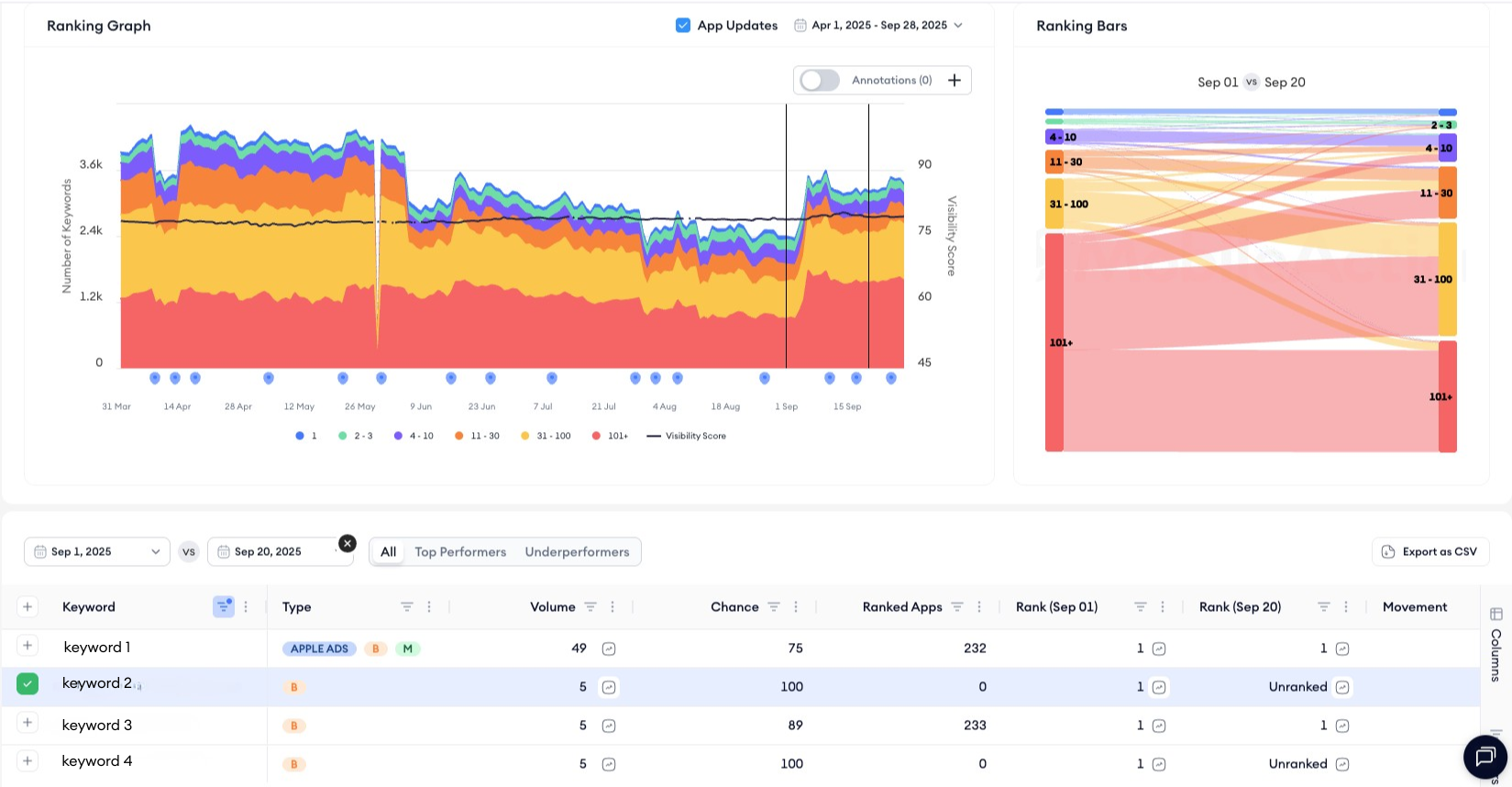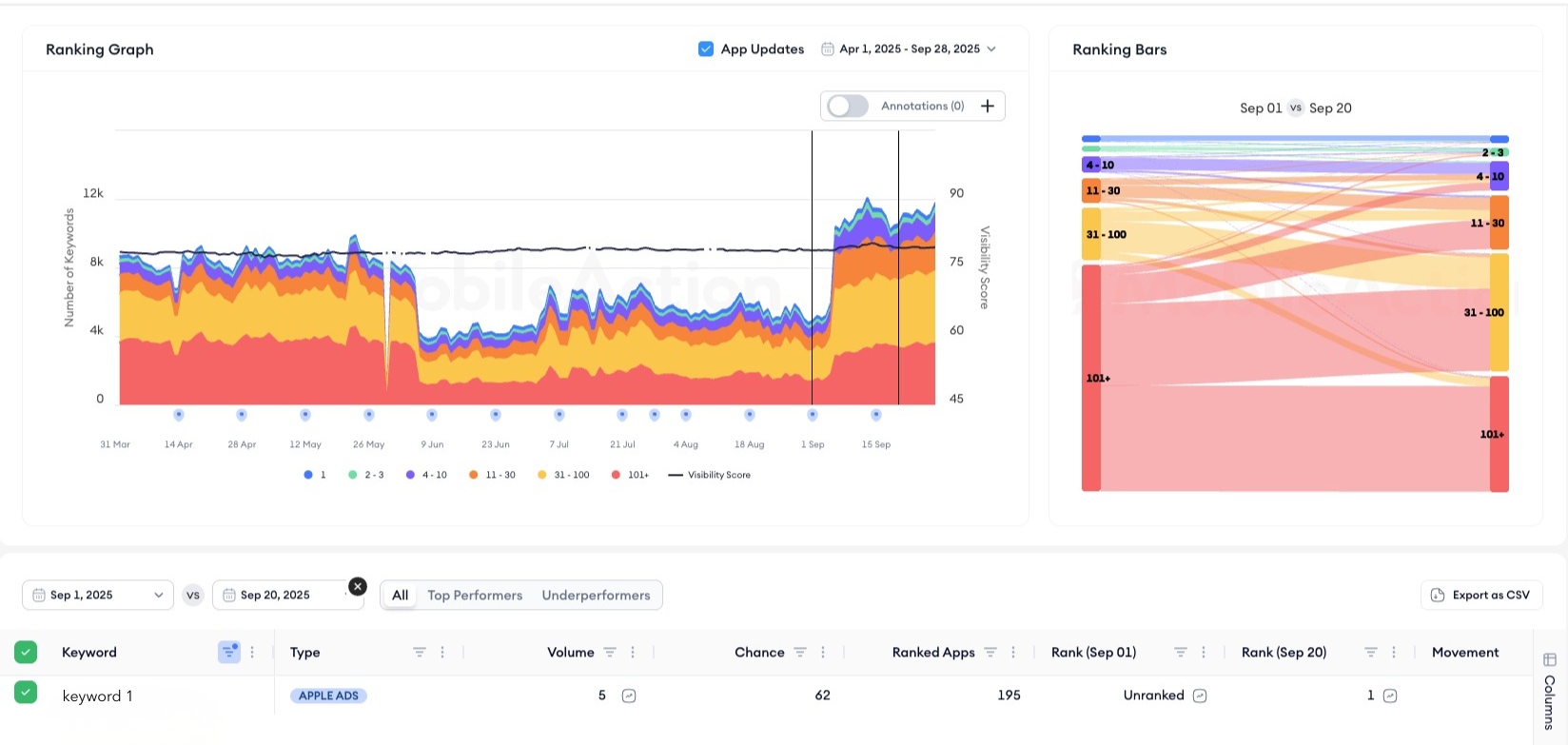Looking to boost your app's visibility and acquire more users? Our 2025 ASO Report is your ultimate guide to navigating the evolving app store landscape. Packed with data-driven insights, keyword trends, and top-ranking app strategies, this report will equip you with the knowledge to optimize your app's presence and achieve organic growth.
Some developers have been noticing massive boosts in their keyword rankings lately. These changes occur mostly for the keywords that developers are not directly targeting with their keyword strategies, suggesting a semantic algorithm direction in the App Store.
In this blog post, we will be examining whether this change felt by our community members is really true or not and what is the reason for it, in line with the validations brought by the hypothesis and tests carried out by the MobileAction team.
What happened in the iOS 18.1 update?
On October 28, 2024, Apple rolled out iOS 18.1. In the update notes of iOS 18.1, Apple announced natural language search silently, only with the following statement: “App Store search lets you use natural language to find what you’re looking for more easily.”
After that, Apple inserted natural language search to its native apps such as Maps, Apple TV, Apple Music, and continues to expand its area of use with additional features such as app tags, and AI-generated summarized user reviews to enhance discovery and search experience, which is announced at WWDC 2025.
This looks like a part of Apple’s broader move toward AI-driven, context-aware search that makes finding the right app more intuitive.
Natural language search explained:
Traditionally, search engines worked by matching the keywords entered with their index, a process known as keyword-based search. To narrow down results, users carried the burden of structuring their queries, often resorting to long or complex inputs to communicate more effectively with the search engines.
And, as queries had to follow a rigid format, the intent behind natural language was often lost.
With natural language search, search has essentially evolved into what it should naturally be. Powered by a machine learning method known as natural language processing, allows users to search using everyday human language rather than relying only on keywords. It translates spoken or written queries into a format computers can understand. Because of its conversational style, it is often called conversational search as well.
While keywords (or key concepts) remain important, with natural language understanding search engines extract deeper contextual information by analyzing the questions (queries) posed, and then using that insight to interpret their context.
Impact on the App Store search
For quite some time, queries like “apps to help me relax” or “best games for stress relief” return more relevant results in the App Store. This means that traditional keyword strategy matters less, as semantic relevance takes priority. And, it’s leveling the playing field. Because even with lower category ranking, an app can rank higher than some of its larger competitors for certain queries if it closely matches user intent.
As there will be a huge amount of new search queries arise in the App Store, natural language search improves discoverability for smaller apps as well. Indie app developers can run after these new queries generated by natural language and get instant search volume.
That’s why, we advise that the focus should be on aligning app metadata and descriptions with the conversational queries users actually make right now.
As with all other apps, small-scale apps may also lose volume on keywords they were previously indexed for due to changes in queries, but this applies to apps across all segments. Therefore, focusing on opportunities beyond the general change is a more reasonable ASO strategy for small-scale apps.
Observations of the MobileAction Team
Devices and iOS Version Validation
Based on multiple tests, we found out that the natural language parameter appears on devices running with iOS 18.1 or later (including iOS 26), even without Apple Intelligence. Keep in mind that over 80% of iPhone users are now using iOS 18.1 or later.
The MobileAction team also tested the US storefront on several iOS devices (including an iPhone 12, iPhone 14 Pro Max, iPhone 16 and iPhone 17) running versions later than iOS 18 and confirmed that natural language search results are active.
For instance, on an iPhone 12 that’s running with iOS 18.5 and a newly created Apple account, natural language queries still returned relevant results in the US storefront.
Storefront Test & Validation
Our test results suggest that the keyword ranking changes are more prominent in English speaking countries. This indicates that natural language search has, for now, been enabled only across English storefronts, specifically the United States, Canada, the United Kingdom, Ireland, Australia, New Zealand, South Africa, India, and Singapore.
In non-English speaking major storefronts such as Germany, France, Türkiye, and China, no meaningful changes were observed for major apps yet.
Impact on the ASO performance of a small app
This muslim dating app shows how natural language search can disadvantage smaller, niche apps. Under the old algorithm, the app ranked first for the branded query “<app brand name> where muslims meet” (volume: 5). With natural language search, the app no longer appears for this query.

Because this dating app relies on branded and long-tail queries for visibility, the algorithm shift creates a significant discoverability risk. Without broad semantic coverage or strong brand power, the app becomes vulnerable to being excluded from relevant results altogether.
The underlying reason is that the App Store’s semantic search engine prioritizes user intent over exact keyword matching. For smaller apps, this means that even if branded terms are present, they may be overlooked if the metadata and tags do not reflect natural, conversational phrasing.
From an ASO perspective, apps like that will need to adapt their metadata and descriptions to mirror how users naturally phrase their searches, strengthen semantic signals with app tags, and encourage reviews that include everyday language. This shift highlights the importance of aligning with intent-driven queries to maintain visibility.
Impact on the ASO performance of a larger-scale app
One of the biggest puzzle games in the world, on the other hand, demonstrates the advantages that larger apps can gain from natural language search. Following the algorithm rollout, its visibility score surged above 90, with more than 4,500 new keywords added, a 76% increase. Many of these came from intent-based queries that better match the way users naturally describe what they are looking for.

Keywords like “puzzle games match 3” or “online castle game” moved from unranked positions into the top 10, creating a noticeable distribution shift. A large share of this puzzle game’s keywords migrated from beyond the 100th position into the highest-ranking buckets, giving the app a significant boost in discoverability.
As a large-scale app with broad coverage, this app is well-positioned to thrive in this environment. Its strong branding, extensive keyword footprint, and metadata that already aligns with user intent allow it to dominate NLP-driven search results. For big apps, natural language search amplifies existing advantages and reinforces their presence at the top of the App Store rankings.
ASO tips and strategies for different growth stages
Indie developers and small-scale apps
For indie developers, natural language search opens up meaningful opportunities to compete with larger players. Because the algorithm now prioritizes intent over sheer volume, smaller apps can gain visibility even without thousands of installs or reviews. Long-tail queries such as “apps to track mood at night” often face less competition, making them a valuable entry point for niche apps. In this environment, semantic relevance creates a fairer competition dynamic, where matching user needs matters more than brand dominance.
From an ASO perspective, indie developers should focus on aligning their metadata and descriptions with natural, conversational phrases that reflect how people actually search. Long-tail keyword research becomes essential, as these low-volume but intent-rich queries can provide a steady stream of qualified users. User reviews are also a valuable source of inspiration, offering real examples of the language potential users rely on to describe their needs.
Large-scale apps
For big players such as Royal Match or ChatGPT, natural language search amplifies existing advantages. These apps gain massive keyword expansion, covering thousands of new queries that mirror everyday language. By doing so, they not only strengthen their dominance in broad category searches but also capture intent-specific use cases they may not have directly targeted before, for instance, ChatGPT surfacing for “AI story writing app.”
To keep this advantage, large-scale apps need to go beyond keyword stuffing. Metadata and creatives should highlight user scenarios directly, showcasing how the app answers diverse intents. Running A/B tests on screenshots, subtitles, and descriptions aligned with different search patterns helps refine this strategy. App tags are also a crucial asset, reinforcing semantic associations and strengthening categorization within the App Store.
New apps launching on the App Store
For newcomers, natural language search creates a rare equalizer. A well-optimized app can surface alongside top players if it closely matches user intent, lowering the traditional barrier of brand awareness. In English-speaking storefronts, where adoption of natural language search is already visible, early optimization can help new apps gain traction faster than before.
The most impactful launch strategy is to design metadata around user problems and goals rather than focusing solely on keywords. Analyzing competitors’ semantic coverage can reveal underserved queries that present opportunities to break into the market. Starting with niche, long-tail queries provide a foundation of relevance, which can later be expanded to broader, higher-volume search terms as the app grows.
Possible impact of Natural Language Search on Apple Ads
As App Store listings shift toward natural language queries, the ripple effects are likely to extend into Apple Ads campaigns. While this doesn’t mean that entirely new demand will suddenly appear, it does change how users phrase their searches, and, in turn, the keywords advertisers should consider targeting.
In this environment, keyword recommendations take on a greater role in helping advertisers surface the right queries, especially within long-tail search terms that reflect real user intent. MobileAction’s ASO keyword discovery modules are designed to detect these evolving “demand footprints” and provide insights that make it easier to adjust Apple Ads strategies in line with natural language search.
Conclusion
Based on our extensive tests, MobileAction stands out as the only ASO platform currently aligned with how Apple’s new natural language search algorithm operates. This alignment means you can track the real shifts happening in keyword rankings, discover which long-tail queries are beginning to matter, and adapt your Apple Ads strategy with confidence.
For indie developers, this offers a chance to compete on intent-driven visibility without being overshadowed by brand power. For larger apps, it provides the scale needed to capture thousands of new queries as they emerge. And for new apps entering the market, it creates an opportunity to launch with data that truly reflects how people are searching today.
If you’d like to experience how natural language search is reshaping visibility, and see why our platform is uniquely positioned to help, you can start your free trial with MobileAction today.





































